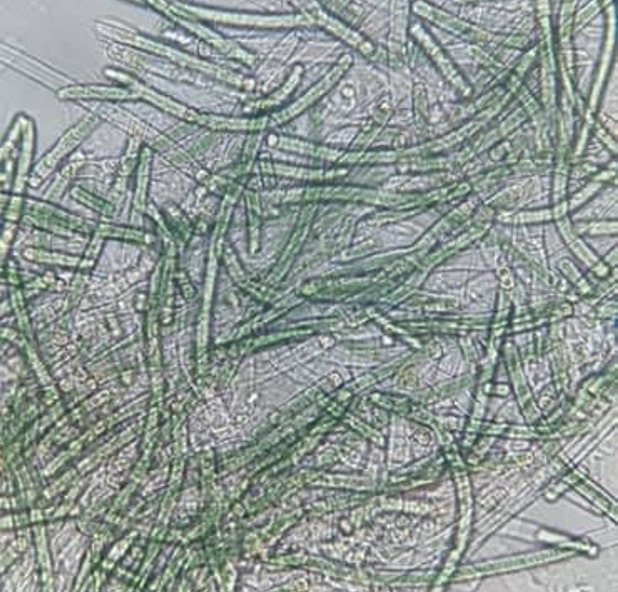By Michelle Chamberlain
Today, humans rely on oxygen to survive, but for the first half of our planet’s history oxygen was scarce. The Earth is approximately 4.54 billion years old and its first life-forms emerged as early as 3.77 billion years ago as single-celled microorganisms. Because these microbes evolved in an anoxic environment, they were obligate anaerobes which meant that they couldn’t tolerate oxygen. Unfortunately for the ancient anaerobes (but fortunately for us), the Earth’s atmosphere underwent a dramatic change around 2.4 billion years ago. This change was caused by cyanobacteria that produce oxygen as a byproduct of photosynthesis. Those bacteria became so abundant that they caused a rapid rise in atmospheric oxygen. Scientists refer to this time as the Great Oxidation Event (GOE).

Cyanobacteria Photo Credit: Michelle Chamberlain
Although other organisms during this time had evolved to use sunlight to generate energy, ancient cyanobacteria were the first known organisms to do oxygenic photosynthesis. During that process carbon dioxide, water, and light are used to generate carbohydrates and oxygen. You might have noticed that this is the same type of photosynthesis that plants do today. In fact, many scientists believe that the organelles responsible for photosynthesis in plants, called chloroplasts, are the remnants of ancient cyanobacteria that were engulfed by larger, more complex cells in a process called endosymbiosis.
Today we think of oxygen as something correlated with life: plants release oxygen and we breathe it in. However, 2.4 billion years ago oxygen was so toxic for most of the microorganisms that the Great Oxidation Event caused a mass extinction. This extinction may be due to oxygen’s reactivity. Oxygen can react with electrons within cells to form chemicals like hydrogen peroxide and superoxide, which are harmful to cell processes and structures. Aerobic organisms, those that utilize and tolerate oxygen, have special enzymes that inactivate those chemicals, but those enzymes may not have been widespread throughout anaerobic life 2.4 billion years ago.

Stromatolite Photo Credit: Dominic Hart, NASA
So, how do we know what happened to life-forms so long ago? One way we can peer into the past is by looking at the isotope composition of ancient rock formations. Because isotopes have different masses, certain reactions favor one isotope over another. During a GOE, sulfur molecules reacted with oxygen in a mass-dependent way which left an imprint of history in the Earth’s geological record. Another way, which you might be more familiar with, is by looking for fossils. One type of formation that is often associated with cyanobacteria is fossilized stromatolites. Stromatolites are layered, rocky deposits that form when groups of cyanobacteria grow together in an arrangement called a microbial mat. The cyanobacteria within those mats are sticky and trap sediment and minerals, leading to the layered formations we observe.
The Great Oxidation Event was one of the most important biological events in Earth’s history. Although it was tumultuous at the time, this global change shaped the way for multicellular life and, thus, humans to evolve. This is because metabolisms that utilize oxygen tend to be more energetically efficient than those that don’t. Only a few anaerobic animals have been discovered to this date and the vast majority of multicellular life is aerobic. Perhaps we are here today because a cyanobacterium took its first breath.
